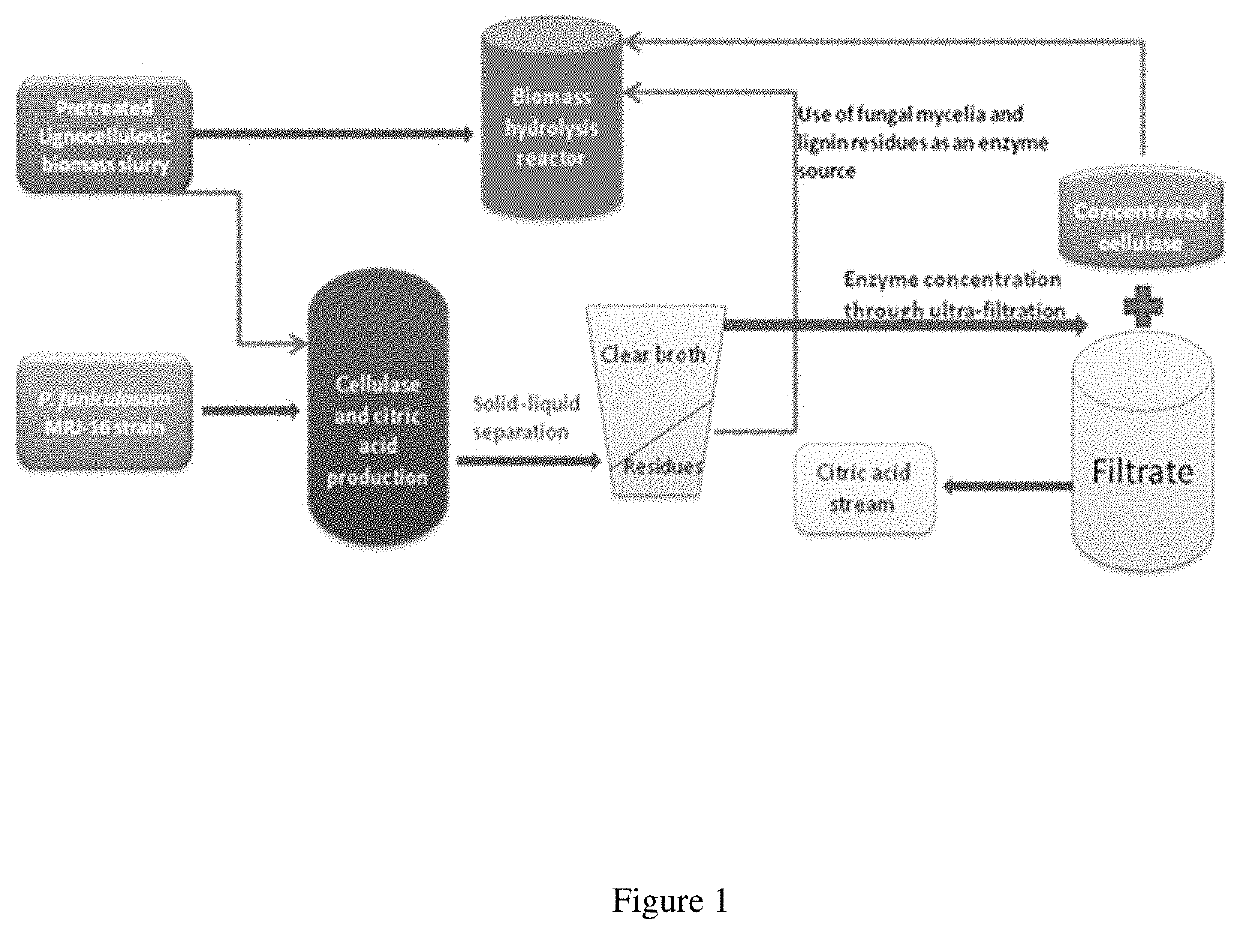Process for simultaneous production of citric acid and cellulolytic enzymes
a cellulolytic enzyme and citric acid technology, which is applied in the field of simultaneous production of citric acid and cellulolytic enzymes, can solve the problems of no viable technology in india, high cost of these enzymes, and high cost of cellulolytic fuel and chemical production, and achieve the effect of increasing enzyme production
- Summary
- Abstract
- Description
- Claims
- Application Information
AI Technical Summary
Benefits of technology
Problems solved by technology
Method used
Image
Examples
example 1
n of Cellulolytic Enzymes Using Pre-Treated Biomass or Cellulose as
[0073]carbon source
[0074](Main Indian Patent Application No. 201821044919)
[0075]For the production of cellulolytic enzymes, the fermentation process was carried out in an aerated stirred tank bioreactor of 7 L glass jacketed vessel with 5 L working volume. Initially, the acid pretreated lignocellulosic biomass such as sugarcane bagasse / rice straw / wheat straw or cellulose in 1:1 or 1:2 ratio was used as carbon source. The pretreatment of biomass was done at 0.5-1.5% w / w sulfuric acid concentration at a temperature of 110-160° C. for 10-30 minutes. The fermentation media components of fermentation media used were 5 g / L ammonium sulphate, 6 g / L KH2PO4, 1 g / L MgSO4.7H2O, 5 g / L CaCO3, 2.5 g / L glycerol, 30 g / L corn steep solids, 30 g / L cellulose and 2 ml / L Tween-80. The fermenter containing 4.5 L medium was sterilized at 120° C. for 20 minutes. After cooling, the temperature was kept at 30° C. and the pH adjusted to 5.5, a...
example 2
ous Cellulolytic / Xylanolytic and Citric Acid Production Using Acid Pretreated Rice Straw Slurry
[0076]An in-house mutant strain Penicillium funiculosum MRJ-16 was used for enzyme and citric acid production. Initially, the whole slurry of lignocellulosic biomass such as Rice straw biomass obtained after dilute-sulfuric acid pretreatment was used as a carbon source at total solid loading 6% (w / v). Pretreatment to rice straw was done at 0.5-1.5% w / w sulfuric acid concentration, at the temperature 110-160° C. for 10-30 minutes. The enzyme production process was performed in a 7 L stirred tank aerobic reactor with 4 L working volume. The composition of the production / fermentation media used was (per L): ammonium sulfate 5 g, KH2PO4 6 g, MgSO4.7H2O 1 g, CaCO3 5 g, Glucose 2.5 g, Copper sulfate 0.1 g, Corn steep liquor 27 g, and Tween-80 2 mL. The 7 L reactor containing 4 L above media and 6% pretreated rice straw were sterilized at 120° C. for 20-30 minutes. Before inoculation, the reactor...
example 3
ous Cellulolytic / Xylanolytic and Citric Acid Production Using Cellulose as Carbon Source
[0077]Cultivation of Penicillium funiculosum MRJ-16 mutant strain was conducted under conditions and media composition identical to example no. 1 except that 3.3% (w / v) cellulose was used as a carbon source instead of 6% pretreated rice straw slurry. As mentioned above, the enzyme broth collected after 96 hours of fermentation was assayed. Analytical determination of enzyme broth resulted in 7.96 FPU / mL, 82.19 IU / mL of β-glucosidase activity, 2.51 IU / mL of β-xylosidase activity, 0.55 IU / mL of α-L arabinofuranosidase activity, 190 IU / mL of xylanase activity, and 125 IU / mL of endoglucanase (CMCase) activity. The results demonstrated that the mutant strain produced 14.60 g / L citric acid from cellulose.
PUM
| Property | Measurement | Unit |
|---|---|---|
| temperature | aaaaa | aaaaa |
| temperature | aaaaa | aaaaa |
| pH | aaaaa | aaaaa |
Abstract
Description
Claims
Application Information
 Login to View More
Login to View More - R&D
- Intellectual Property
- Life Sciences
- Materials
- Tech Scout
- Unparalleled Data Quality
- Higher Quality Content
- 60% Fewer Hallucinations
Browse by: Latest US Patents, China's latest patents, Technical Efficacy Thesaurus, Application Domain, Technology Topic, Popular Technical Reports.
© 2025 PatSnap. All rights reserved.Legal|Privacy policy|Modern Slavery Act Transparency Statement|Sitemap|About US| Contact US: help@patsnap.com

